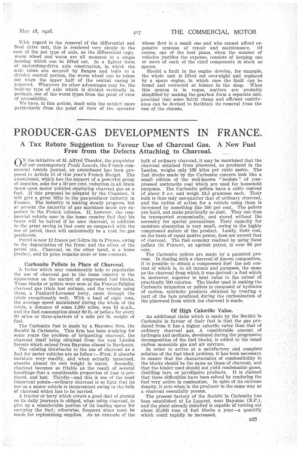PRODUCER-GAS DEVELOPMENTS IN FRANCE.
Page 17

If you've noticed an error in this article please click here to report it so we can fix it.
A Tax Rebate Suggestion to Favour Use of Charcoal Gas. A New Fuel Free from the Defects Attaching to Charcoal.
irIN the initiative of M. Alfred Theodor, the proprietor kJ' of our contemporary Folds Lourds, the French commercial vehicle journal, an amendment has been proposed to Article 15 of this year's French Budget. The amendment; which has the support of a powerful group of deputies, asks for a 50 per cent, reduction in all State taxes upon moter yehicles employing charcoal gas as a fuel. If this proposal be adopted by the Chamber, it will give a great fillip to the gas-producer industry in France. The industry is making steady progress, but at present the Majority of gas machinesmade are exported to the French colonies. If, however, the commereiai vehicle user in the home country find that his taxes will be halved if he uses charcoal, in addition to the great saving in fuel costs as compared with the use of petrol, there will undoubtedly be a rush for gas producers, Petrel is now 12 francs per 5-litre tin in France, owing to the depreciation -of the franc and the effect of the petrol tax. . Charcoal, on the other hand, is a home product, and its price remains more or less constant.
Carbonite Pellets in Place of Charcoal.
A factor which may considerably help to popularize the use of charcoal gas in the home country is the appearance on the market of compressed fuel blocks. These blocks or pellets were seen at the Franco-Belgian charcoal gas trials last autumn, and the vehicle using them, a Panhard-Levassor lorry, came through the trials exceptionally well. With a load of eight tons, the average speed maintained during the whole of the trials, a distance of some 1,380 miles, was 18 m.p.h., and the fuel consumption about 80 lb. of pellets for every (30 miles or three-quarters of a mile per lb weight of fuel.
The Carbonite fuel is made by a Bayonne firm, the Societe in Carbonite. This firm has been studying for some years the problem of briquettiug charcoal, the charcoal itself being obtained from the vast Landes -forests which extend from Bayonne almost to Bordeaux.
The existing drawbacks to the use of charcoal as a fuel for motor vehicles are as follow :—First, it absorbs moisture veryreadily, and when actually immersed, absorbs almost its own weight in water. Secondly, charcoal becomes so friable as the result of several handlings that a considerable proportion of dust is pro-' duced, and lost. Thirdly—and this is one of the most important points—ordinary charcoal is so light that its use on a motor vehicle is inconvenient owing to the bulk of charcoal which has to be carried.
A tractor or lorry which covers a.good deal of ground on its daily journeys is obliged, when using charcoal, to give up a considerable portion of its loading space for carrying the fuel ; otherwise, frequent stops must be made for replenishing supplies. As an example of the
bulk of ordinary charcoal, it may be mentioned that the charcoal obtained from pinewood, as produced in the Landes, weighs only-169 kilos per cubic metre. The fuel blocks made by the Carbonite concern look like a small edition of the well-known " boulets " of compressed anthracite coal which are used for household purposes. The Carbonite pellets have a cubic centent of about 3 e.e. and weigh 13.5 grammes each. Their bulk is thus only one-quarter that of ordinary charcoal, and the radius of action for a vehicle using them is increased by something like 300 per cent. The pellets are hard, and make practically no dust. They can thus be transported economically, and stored without :Elie necessity for special precautions. Their capacity for moisture absorption is very small, owing to the highly compressed nature of the product. Lastly, their cost, on the basis of equal motive power, does not exceed that of charcoal. The fuel economy realized by using these pellets (in France), as against petrol, is over 60 per cent.
The Carbonite pellets are made by a patented process. In dealing with a charcoal of known composition, it is possible to obtain a compressed fuel the ash content of which is, to all intents and purposes, the same as the charcoal from which it was derived ; a fuel which is, moreover, superior in heat value to the extent of practically 500 calories. The binder used in making the Carbonite briquettes or pellets is composed of hydrates of carbon, synthetic products obtained by treating a part of the tars produced during the carbonization of the pinewood from which the charcoal is made.
Of High Calorific Value.
An additional claim whieh is made by the Socihte in Carbonite in favour of their fuel is that the gas produced from it has a higher calorific value than that of ordinary charcoal gas. A considerable amount of hydrogen and methane, developed during the progressive decomposition of the fuel blocks, is added to the usual carbon monoxide gas and air mixture.
In order to arrive at a satisfactory and complete' solution of the fuel block problem, it has been necessary to ensure that the characteristics of combustibility in the blocks should be the same as those of charcoal, and that the binder used should not yield condensable gases, distilling tars, or pyrolignite products. It is claimed that these difficulties have been solved by rendering the fuel very active in combustion. In spite of its extreme density, it acts when in the producer in the same way as a charcoal essentially porous.
The present factory of the Societ4 la Carbonite has been established at Le Lazaret, near Bayonne (B.P.), and the plant already installed is capable of turning out about 25,000 tons of fuel blocks a year—a quantity which could rapidly be increased.


























